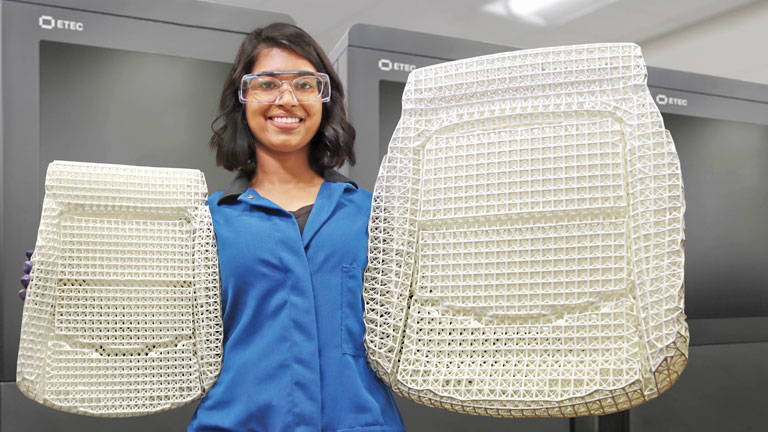Desktop Metal Inc. was founded in 2015 without any plans to make a high-volume printer. It is now encouraging 3D printing for serial production under its AM 2.0 initiative.

“We’re really pushing to make sure our equipment is robust enough and reliable enough to really support the demands of true industrial production, and that it’s also delivering the materials and the accuracy (that are) requirements of industrial production and throughput,” said Sarah Webster, chief marketing officer. She cited an unnamed customer in Germany who’s using AM for “true high-volume automotive production.”
Along with its move to push 3D printing out of the office and onto the factory floor, Desktop Metal recently acquired a business that has led to new material offerings, and another that’s a pioneer in additive manufacturing in Italy.
FreeFoam was developed and invented by Adaptive 3D, a Texas-based photopolymer/elastomer materials firm. This subsidiary of Desktop Metal was established following a 2021 purchase. The new material is a photopolymer resin that contains heat-activated foaming agent. It is then printed and heated to expand in controlled ways to seven times its original size. It can be used in furniture, footwear, sports goods, automotive, and other areas where it can make lightweight seating.
“If the seats are up to 50 to 80 percent lighter, depending on the design, just imagine what this change could make in the millions and millions of cars that are traveling our roadways,” Webster said. “This doesn’t matter if you only do it in 10 cars or 100 cars. But if you do it in millions of cars, we start to talk about additive really reshaping our world.”
Desktop Metal has at least two new materials, FreeFoam and it was created by Adaptive 3D. DuraChain, another two-in-one category of photopolymers, is a product that phases separate at the nanolevel and cures to a material that has a resilient, high performance network.
Desktop Metal purchased Italian hydraulics and fluid power maker Aidro srl in September 2021. Aidro’s designs for AM included parts consolidation and lightweighting as well as new geometries that allow for inventory to be stored in a way that has been used for 70+ years.
“At that time, there was no other company (in Italy) in the hydraulics or fluid power sector already using AM,” said Valeria Tirelli, who is co-CEO and president of Aidro. “So we were a kind of pioneer.”
AM was the catalyst for other developments at Aidro. Aidro was awarded AS9100 Certification. In June 2022, it became a supplier of 3D printed aluminum flight parts to Leonardo Helicopters. Aidro’s AM experience allowed it to work with several large-name oil and natural gas companies for two years in order to develop the process for 3D-printed parts that can be used in this sector. The Milan-based company also works on digital inventories to replace parts warehouses. This is a difficult endeavor that will pay off in the event of a need for spares.
“More than 50 percent of these parts will never be used,” she noted.
Aidro’s success with 3D printing has Tirelli thinking about automation, too. Tirelli sees automation as a way to automate the handling of metal powders that are used to make parts, and also for de-powdering finished products after processing.
Automation is also on Desktop Metal’s agenda.
“Yes, we have envisioned robots being part of the de-powdering process for serial production,” said Webster. “But there are other types of automation for de-powdering—vacuums, cyclones—there’s a lot of things that have been explored for removing powder in an automated way.”